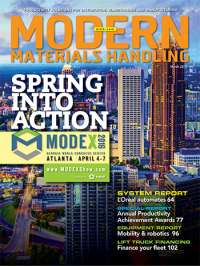Packaging Corner: Palletize without barriers
Collaborative robotics is on the horizon for palletizing, but we’re not there just yet.
Latest Material Handling News
New resource center for weighing and dimensioning Protective packaging roundup MODEX C-Suite Q&A: Troy Donnelly, Senior VP of Sales, Marketing, and Application, DMW&H When Just-in-Time Just Doesn’t Work Recycling coastline plastic into premium reusable packaging More ColumnsOne of the biggest trends in robotic systems developed for use within warehousing pick, pack and kitting operations has been collaboration. This refers to robotic mechanisms that work side by side with humans and interact as needed within a workcell, but with no physical safety barrier between the two.
ABB Robotics’ latest offering in that space is the small-parts-handling YuMi, says Rick Tallian, manager of picking, packing and palletizing products and applications.” Users with space constraints in their palletizing zones are eager to see the same type of barrier-free interaction on robotic palletizers that are much larger,” he says, adding that ABB is developing such a solution now.
However, some suppliers may be over-promising on current collaborative robotic palletizer capabilities, he cautions. Before a facility considers purchasing such equipment, a few key points are important to keep in mind.
First, standards for the safe design and operation of collaborative robotic technologies (including palletizers) are still under development by the Robot Industries Association (RIA) and the International Organization for Standardization (ISO). There are, however, “very specific guidelines (ISO 10218) established to determine safe operation conditions for robotic devices and the cell around the robot,” Tallian notes.
Second, “both organizations recommend that a trained professional perform a risk evaluation of your operation prior to installing equipment,” he explains. “Make sure you understand the amount of force a robot may impart if it contacts a person, and that speed and torque limiting features should be integral to the robot’s design to prevent injury.”
Third, the robotic palletizer’s task parameters may preclude a collaborative model simply by nature of the packages being handled, Tallian notes: “Most of the robotic operations performed in manufacturing and warehousing are designed to maximize the speed and throughput. But a typical palletizing operation—handling heavy boxes and moving massive robot arms at high speeds—does not qualify for current collaborative robotic mechanisms on the market today.”
For now, he adds, space-limited operations wishing to remove a physical safety barrier around a palletizer do have other options. “There are safety technologies—including light barriers and photo eyes—that detect the presence and proximity of a person and trigger the robot to slow down or stop at certain points for safety.”

Article Topics
Columns News & Resources
New resource center for weighing and dimensioning Protective packaging roundup MODEX C-Suite Q&A: Troy Donnelly, Senior VP of Sales, Marketing, and Application, DMW&H When Just-in-Time Just Doesn’t Work Recycling coastline plastic into premium reusable packaging Fresh food, anyone? RPCs protect in the supply chain Why Isn’t Your Loading Dock Connected to Your Supply Chain? More ColumnsLatest in Materials Handling
Registration open for Pack Expo International 2024 Walmart chooses Swisslog AS/RS and software for third milk processing facility NetLogistik partners with Vuzix subsidiary Moviynt to offer mobility solutions for warehouses Materials Handling Robotics: The new world of heterogeneous robotic integration BSLBATT is looking for new distributors and resellers worldwide Lucas Watson appointed CSO for Körber’s Parcel Logistics business in North America Hyster recognizes Dealers of Distinction for 2023 More Materials HandlingAbout the Author
Subscribe to Materials Handling Magazine

Find out what the world's most innovative companies are doing to improve productivity in their plants and distribution centers.
Start your FREE subscription today.
April 2024 Modern Materials Handling

Latest Resources











